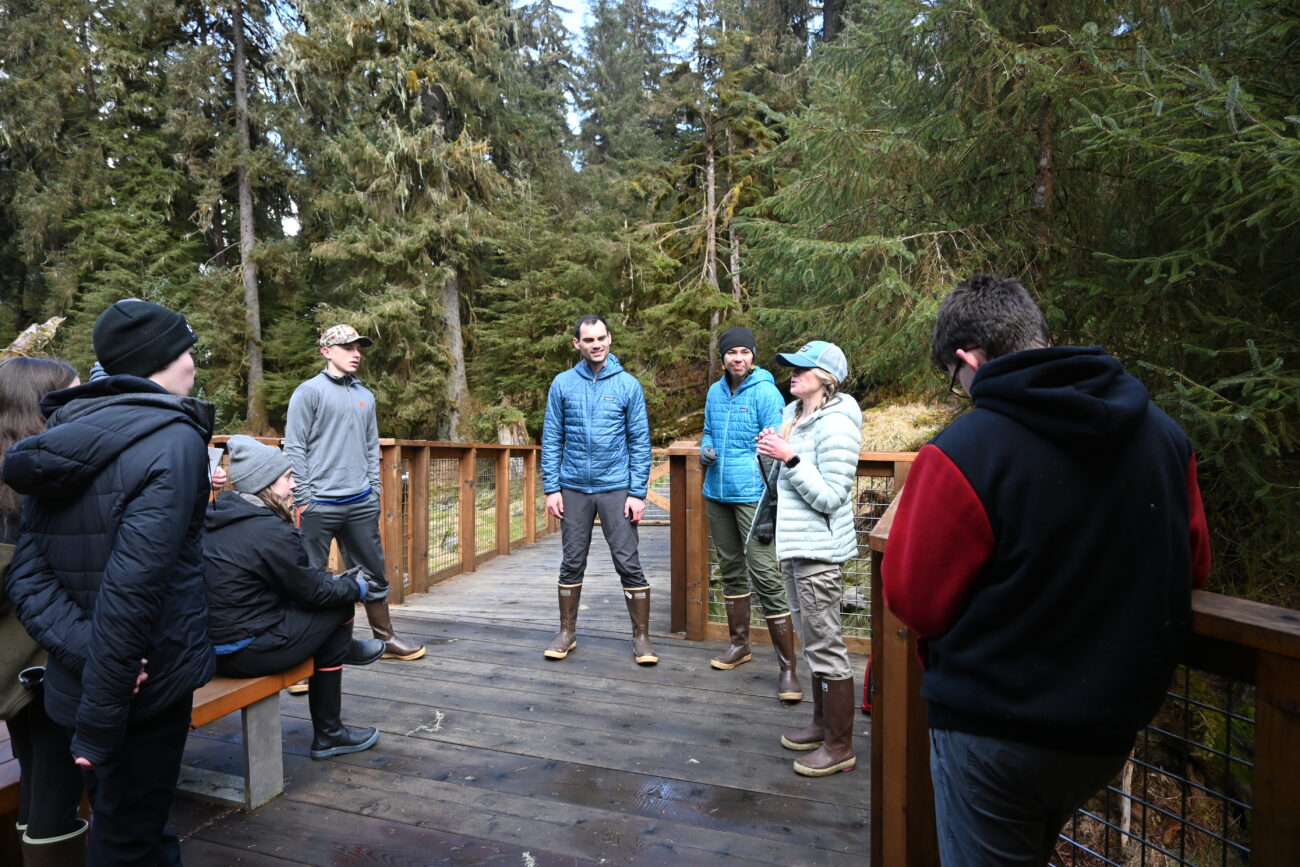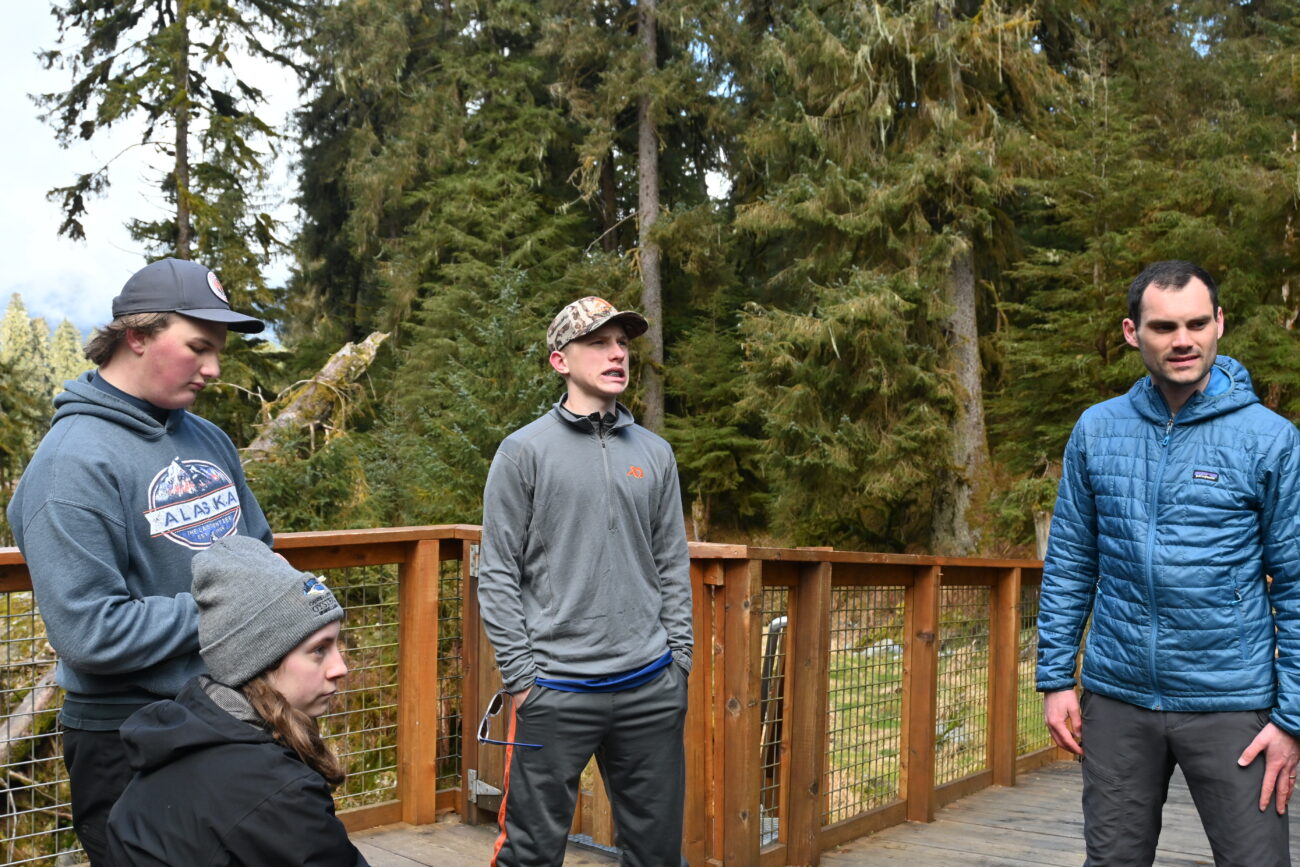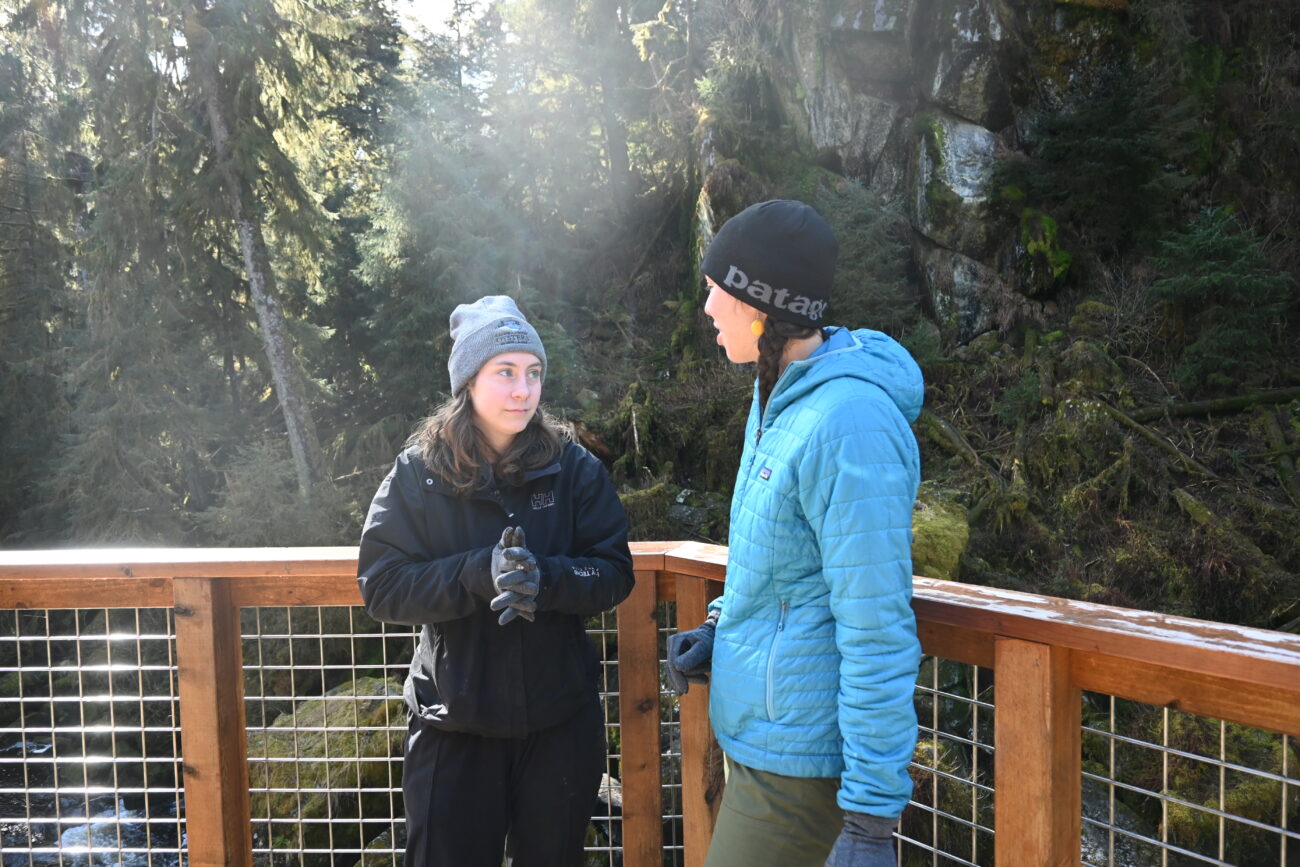
Just before the group hiked a quarter-mile to the observation deck, we heard the sound of the boat motor leave to drop anchor after our National Forest Service captain dropped us off at the trailhead at Anan Bay. The sun peaked out, which hit the still moist ground – after all, it is the Tongass National rainforest. Moss blanketed downed trees and usnea – also called old man’s beard – hung from the tall evergreen trees.
“If we did see a bear we’re gonna group up,” Jen Kardiak, U.S. Forest Service Anan Camp Manager said. “I’ll start talking to it and then I’ll guage if we need to back up to give it some room to either go up or down the side of the trail. But most important, don’t scream or don’t run and we all stay together.”
Kardiak led high school students, educators with T3 Alliance and myself along the gravel trail that winds through the trees.
T3 Alliance – Teaching Through Technologies – has been teaching Wrangell students STEM (Science, Technology, Engineering and Math) skills with this current project. The collaboration between the school, the Forest Service and T3 is a five-year program funded through a $300,000 grant.
Before the bear season gets rolling, a group of 14 Wrangell High School students has visited Anan Bear Observatory a few times, about 30 miles from town. They’ve teamed up with the U.S. Forest Service to set up live bear cameras. On this particular day, only six students could participate because of other commitments, including spring break.
Claire Froehlich, U.S. Forest Service park ranger, said getting the work done before bear season picks up makes it easier on everyone.
“With the bears and everything, it becomes harder, because then every trip to point A to B is its own challenge of safety and everything,” she said. “And then getting large equipment out here for bringing a bunch of solar panels, you probably wouldn’t want to do that right before the season, because that’s not (safe), you know…so all those things need to happen now.”
Froehlich said that this is their third visit to Anan.
“We went out once about two and a half weeks ago, and then maybe three weeks ago,” she said. “We knew that spring break was coming up. And I knew that a lot of the students who were working on this project were going to be available.”
The group brought a generator because the observatory deck is very remote with no power source.
A drone flew past the deck and overhead above the swiftly flowing river. Students captured visuals of the area with it to find the best spots to set up live cameras.
Jackson Carney, freshman in high school, said it’s his first project with the group.
“We want a fish cam, we want one up here, and we want another one somewhere and we’re not 100% sure about that one,” he said. “(For) the bottom ones on the observation deck, we actually have to wait until construction is done to place.”

As students discussed the cameras’ placements, Claire Froehlich helped them figure out optimal areas.
“You can’t get a good front facing view of it because it’s on a cliff,” she said. “It’s going down to a rapid.”
She said they’re trying to get a good canopy map and see where the open areas are. They want to put cameras at the upper falls, so they snap pictures of that area too.
Froehlich said, “How do you armor cables that run out past three miles for power and data connection in an area that is not so forgiving with bears and weather and temperature?”
At the observation deck, T3 Contractor Michelle Cordell addressed some students.
She asked the students, “Now that we’re back on the deck, do you think that your designs and choices from yesterday still make sense?”
“Yes,” they said. “Yes.”
Junior Ander Edens received his drone pilot license through T3. He’s been involved with T3 for the past two years and started working on Anan this past December. He said the ultimate goal is to get five cameras installed but this year they’re focusing on just two.
“I really love this planning phase,” he said. “But I really do want to push forward to installation just, like, get everything ready, move, keep moving. And then of course next year we’re going to have a really other challenging project within this project still.”
That’s phase two, where they will set up a camera about 2,000 feet northeast from the observatory deck, at upward falls.
As the sound of the river rapidly flowed through the area, the students split into two teams of three and started working on their goals –power, Starlink internet, 12 solar panels and camera placement.
While they discussed where to place conduit connections, Kardiak gave a few suggestions and told them to make sure the wires are in metal because bears love anything that has a plastic, oily taste.
“Just be cognizant that bears are like puppies,” she said. “They will chew on everything.”
She also had a fun suggestion on where to place one of the cameras.
“Now we want to not only provide the viewing opportunity of the salmon because it can be really cool to see the bear claw come in and catch a fish when the cameras focused on it,” Kardiak said. “But also now, just for outreach because there are people that will never make it to Alaska.”
Brian Reggiani, University of Alaska Fairbanks Associate Director for Upward Bound, said Upward Bound works closely with T3.
“You guys did an awesome job yesterday evening, mocking up some of those drawings and designs for the underwater camera,” he said. “First to camera placements, this time with Jen and Claire here is really precious.”
Reggiani said T3 and Upward Bound found a common link that helps students thrive.

“One of the things that we found that really makes a difference is these community impact projects,” he said. “So anytime that students can be working on a project that helps their community, it really helps them with buy-in, and they’re really excited to learn and grow and help out.”
Freshman Madelyn Davies joined the T3 program about a month ago.
“We’ve got a lot of measurements for where we can place solar panels and their wires,” she said. “Like how it’s (wires) gonna run unseen.”
“Yeah, we got some ideas on how to connect everything and how it’s all gonna work out,” sophomore Kalee Herman, Davies’s teammate said.
Before everyone had to leave, the students continued discussing camera placement.
“I was thinking we have one camera for this whole area and then another camera, another on the side or on the corner over there,” Edens said to his group. “Because there’s a popular fishing spot down there.”
Kardiak responded, “Wolverine?”
“Yeah,” said Edens.
“This is her favorite spot right there,” Kardiak said.
Soon after the group consensus, it was time to head back to the boat before the tide receded. As we retraced our steps on the path a weasel tried crossing the path in front of us. Everyone in the group stopped to watch. Some took pictures. Shortly after that experience, seals swam towards us as we were steps from hopping on board to head back home.
The students decided to place one camera showing the caves where the bears like to hang out and the other will be an underwater fish camera. They also ordered all the equipment needed to complete the project.
Besides the bear cams, Edens and other students also designed a Forest Service cabin at Little Lakes in Wrangell. It will be constructed this summer.
The students will eventually earn a badge, which is a type of engineering certification that says they worked on a large project. They’ll also get engineering credits.












